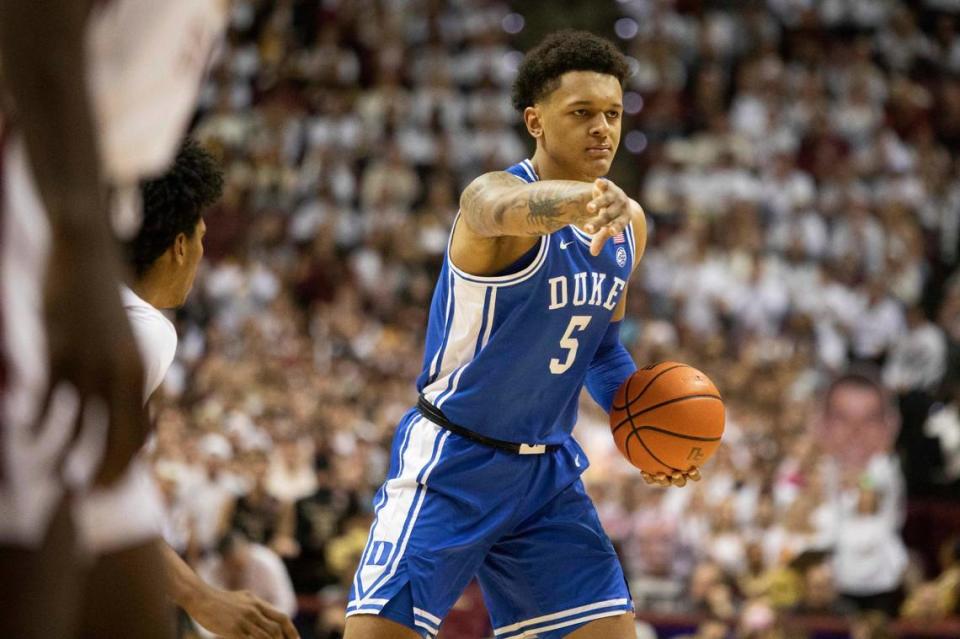Duke’s two ACC losses highlighted by uncharacteristically high turnover rate
Overall, Duke remains one of the better teams in the country when it comes to protecting the basketball and not turning it over.
A deeper look, though, shows a chink in the No. 6 Blue Devils’ armor that needs attention.
When Duke faces teams with athletic, veteran players, especially lately, the Blue Devils tend to turn the ball over more than usual.
That was the case Tuesday night at Florida State, when Duke’s 15 turnovers played a big role in what became a 79-78 overtime loss to the Seminoles.
Those miscues were similar to Duke’s performance on Jan. 8, when the Blue Devils turned it over a season-worst 17 times while losing 76-74 at home to Miami.
For the season, Duke has only averaged 10.2 turnovers per game. At times the Blue Devils have been magnificent at not wasting possessions, like when they only had eight turnovers in their 84-81 win over Gonzaga in Las Vegas on Nov. 26.
In that game, according to Ken Pomery’s advanced statistics, Duke turned the ball over on just 10.1% of its possessions. That’s better than Duke’s season average of 14.4%, which is No. 11 nationally.
In the Miami game, that jumped to 23.9%. At Florida State, it was 21.1%.
Where the Hurricanes had sixth-year seniors Charlie Moore and Kameron McGusty in their backcourt, Florida State threw seniors RayQuan Evans and Anthony Polite at the Blue Devils.
“I thought it was the most physical game we’ve been in,” Duke coach Mike Krzyzewski said. “They knocked us back for most of the first half.”
Three Duke starters were guilty of most of the turnovers at FSU. Paolo Banchero and Wendell Moore each had four while playing 42 and 38 minutes. Trevor Keels had three while limited to 29 minutes due to a calf injury that kept him out of the game’s final 15:11.
It’s not yet been determined if Keels will be available when Duke (14-3, 4-2 ACC) plays Syracuse at noon Saturday at Cameron Indoor Stadium. He’s started every game and has been a key factor in Duke’s success this season.
Yet, against Florida State, Duke played some of its best offensive basketball once he left the game. Jeremy Roach, a 6-3 sophomore, turned the ball over just once in 29 minutes of play while dishing out six assists.
He was particularly effective as Duke, after trailing 59-50 with 6:52 to play, took a 67-65 lead before Evans’ basket with 1.4 seconds left sent the game to overtime.
“We were just much stronger with the ball during that time period and made really good plays as a result of it,” Krzyzewski said. “It was really not kind of an x and o game. They’re going to take you out of every play, so you’ve got to make plays. I thought we started making plays and Jeremy and Paolo were a key to that.”
Duke turned the ball over just twice in the final 10 minutes of regulation and the five-minute overtime. Prior to that, the Blue Devils produced .941 points per possession in the game. They finished at 1.14.
When Duke doesn’t turn the ball over, it’s one of the nation’s most potent offenses.
So the problem is easy to identify. The task is to repair it.
Banchero said Florida State’s pressure defense, where the Seminoles aggressively attacked the passing lanes even out on the perimeter, kept the Blue Devils from getting the ball where they were comfortable attacking the basket.

The Seminoles, he said, were “making us catch outside of where we wanted to start our offense at. They put good pressure off the ball and on the ball. Then, we turned it around I think by getting out in transition and then driving and kicking.”
Driving and kicking the ball out to shooters worked well for Duke in the games following the loss to Miami. The Blue Devils played offense at a high level in beating Wake Forest, 76-64, and N.C. State, 88-73, last week.
Duke had seven turnovers, a solid 10.1% rate, to go with 13 assists at Wake. In beating N.C. State, the Blue Devils’ turnover rate crept back up to 17.4% with 12 turnovers. But their 23 assists meant they assisted on a whopping 65% of their made field goals, a sign of good ball movement.
With or without Keels, this is the type of basketball Duke must play going forward: Strong passes, controlled drives to the basket along with hustling after loose balls.
Plenty of time remains to get this fixed and if the Blue Devils do it, a home loss to Miami or a one-point overtime setback at Florida State will be small prices to pay for lessons learned.
But the learning has to happen because the teams Duke will play in March in the NCAA tournament are likely to have veteran guards or those teams wouldn’t be there.
